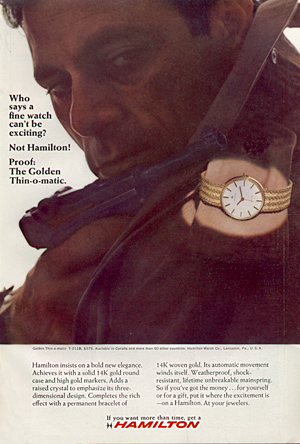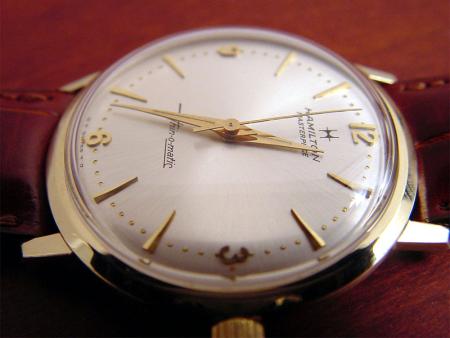An Artifact of Innovation: The Hamilton/Buren Intramatic by John Davis May 21, 2001
Part I

The first ever micro-rotor automatic watch movement was patented by Uhrenfabrik Büren A.G. in the mid 50s. When their "planetary rotor" automatic movement was released in 1957 in the "Super Slender" line, it was one of the flattest automatics of its time and derivatives of the movement competed with the Universal Geneva micro-rotor for thinnest automatic in the world for many years. The most famous implementation of the Buren micro-rotor was to be found in Hamilton's "Thin-O-Matic" line but also could be found for a period in Bulova's "Ambassador" line and Dugena's "Super". Although Hamilton produced Thin-O-Matics with high-grade ETA movements as well, they were so fond of the Buren movement that in 1966 they purchased the company.
Hamilton (which became Hamilton International S.A. in 1968) kept producing fully assembled watches under the Buren name as one of their "economy" lines (alongside Huguenin (whom they purchased in 1959) and Vantage (purchased in 1962)). They kept Hans Kocher (Buren's chief designer) on as the president of Buren Watch Company S.A. which they owned and operated until Hamilton was in turn purchased by SIHH (later called SMH, now the Swatch Group) in 1971 (a controlling interest was purchased at that point, all watchmaking assets were then completely turned over in 1974). Buren went into liquidation within months.
Founded in 1873 by F. Suter, Buren's first automatic movement (Cal. 525) released in 1945 showed a novel approach to automatic winding that was indicative of things to come. It used a pendulum winding mass recessed into the movement, resulting in a thinner automatic system than other movements of its time. It was a fragile and not particularly efficient system and could not compete with rotor winding systems, even as found in the early bumper automatics of other manufacturers. In 1952 Buren released their first full rotor automatic with bi-directional winding (Cal. 541). It featured a massive rotor surrounding a small (9 1/4-ligne) movement. The smaller movement was made more accurate by the state of the art Glucydur balance and Nivarox hairspring and in 1953 they created the Cal. 538, the smallest automatic calibre with power reserve indicator, a device to assure the public that this new fangled automatic winding stuff really worked.

In 1954, through the efforts of Hans Kocher, their chief designer, Buren patented a micro-rotor winding system (they called it a "planetary rotor") that finally saw production in 1957. By 1962, the design had been refined into the Cal. 1280 "Intramatic" which won the Prix D'Honneur at the 1964 Swiss National Exposition in Lausanne. In 1965 it was further refined into the Cal. 1320 (1321 and 1322). Both designs (the 1280 and 1320) featured a slightly larger swinging mass than the earlier models, which now swung over the center of the movement, necessitating indirect seconds and minutes (I'll explain that later). Like the "Super Slender", the "Intramatic" wound in both directions and featured mutual decoupling of the automatic and manual winding systems (more about that later also) in an attempt to capitalize on all the winding power that could be squeezed out of its tiny rotor.
It was the "Intramatic" movement that Buren modified in a joint venture with Breitling-Leonidas, Dubois-Depraz, Hamilton (who owned Buren at that time) and Heuer to create one of the world's first automatic chronographs in 1969, the "Chronomatic". The "Chronomatic" featured a Dubois-Depraz chronograph module (8510) attached to the backside of the movement, effectively hiding the micro-rotor entirely within the movement.
The last automatic movement that Buren made was the Cal. 82, which utilized twin barrels on either side of the center wheel pinion and a large central rotor. It could run at 28,800 bph or 36,000 bph and experiments were made with a 43,200 bph escapement. It was quite thick for its time (at 6.2 mm) and consequently only two or three hundred watches were ever completed with the Cal. 82 movement. The remaining parts for approximately 100,000 more were sold to Comor in 1971.
References:
Automatic Wristwatches From Switzerland, Heinz Hampel © 1992 Schiffer
Wristwatches Armbanduhren Montres Bracelets, Gisbert L. Brunner & Christian Pfeiffer-Belli © 1999 Könemann
Thanks are due to Tim C, jim b+ and Paul Delury for providing historical information from various sources.
Images:
Hamilton Thin-O-Matic Ad courtesy of Paul Delury
Thin-O-Matic #1 courtesy of Greg Leveto (AntiqueVintageWatches.com)
Bulova Ambassador courtesy of Gary Hurst
Dugena movement courtesy of Rob B. (photo by Paul Delury)
Buren 1321 movement courtesy of Rob B. (photo by Paul Delury)
Hamilton Thin-O-Matic (in red) courtesy of Kent Lee
All Rights Reserved
